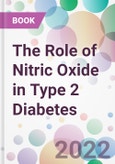This book is a collection of reviews that deal with the role of nitric oxide in type 2 diabetes, providing a unique overview of NO signaling, and pointing out key areas for more detailed research. The
book includes contributions about the pathophysiology of T2D, a brief history of discovery and timeline of NO research, a comprehensive overview of impaired NO metabolism in T2D, precursors of NO (i.e., L-arginine, L-citrulline, nitrate, nitrites, and NO donors), NO and T2D from genetic points of view, NO and diabetic wound healing, NO and osteoporosis, NO and hyperuricemia, NO and Alzheimer’s Disease, therapeutic applications of NO and NO donors in T2D. The compilation is of great value to anyone interested in the biochemistry of NO and its relationship to diabetes.
Table of Contents
Chapter 1 Introduction- Chemical Structures, Classification And Properties Of Flavonoids 4 Classes Of Flavonoids With The B Ring On C2
- Classes Of Flavonoids With The B Ring On C3
- Classes Of Flavonoids Where The B Ring Is Connected To The C Ring Through The 4Th Position
- Classes Of Open-Chain Flavonoids
- Pharmacological Aspects Of Polyphenols And Flavonoids
- Bioavailability And Metabolism Of Flavonoids, Toxicological Activity And Semi-Synthetic Strategies
- Adme Of Flavonoids
- Factors That Could Affect Adme Of Flavonoids
- Toxicity Of Flavonoids
- Strategies For A Better Investigation Of Flavonoids Properties
- Conclusion
- Consent For Publication
- Conflict Of Interest
- Acknowledgements
- References
- Barbara De Filippis And Marialuigia Fantacuzzi Introduction
- Multitarget Analogues Of Rsv
- Hybrids Of Rsv
- Derivatives Of Rsv
- Schiff Base Derivatives Of Rsv
- Concluding Remarks
- Abbreviations:
- Consent For Publication
- Conflict Of Interest
- Acknowledgements
- References
- Cristina Scarpecci And Sara Consalvi Introduction
- Xanthone Synthetic Derivatives For Cancer Therapy
- Caged Xanthones (Cxs)
- Mangostin Analogs
- Carboxyxanthones
- Dihydroxyxanthones
- N-Xanthone Benzensulphonamides
- Dioxygenated Xanthones
- Xanthones Bearing Long Side Chains
- Antibacterial Xanthone Synthetic Derivatives
- Amphiphilic Xanthones
- Amino Acid-Conjugated Xanthones
- Miscellaneous Compounds
- Antifungal Xanthone Synthetic Derivatives
- Antimalarial Xanthone Synthetic Derivatives
- Xanthone Synthetic Derivatives As Anti-Inflammatory Agents
- Anti-Alzheimer Xanthone Synthetic Derivatives
- Xanthone Synthetic Derivatives As Α-Glucosidase Inhibitors
- Concluding Remarks
- Consent For Publication
- Conflict Of Interest
- Acknowledgement
- References
- Alessandra Ammazzalorso And Trond Vidar Hansen Introduction
- Insights On Mechanism Of Action Of Combretastatins
- Development Of Combretastatin Prodrugs
- Fosbretabulin, Ombrabulin And Oxi4503
- Combretastatin Prodrugs With Improved Drug Delivery Ability
- Bioreductive Prodrugs Of Combretastatins
- Photoresponsive Hybrid Prodrugs Of Combretastatins
- Development Of Combretastatin Derivatives
- Combretastatin Derivatives Obtained By Bridge Modifications
- Carbocyclic Derivatives
- Heterocyclic Derivatives
- Recent Advances In Drug Delivery Systems Of Combretastatin
- Concluding Remarks
- Abbreviations
- Consent For Publication
- Conflict Of Interest
- Acknowledgement
- References
- Federico Appetecchia, Mariangela Biava And Giovanna Poce Introduction
- Flavonoids
- Chalcones
- Simple-Substituted Chalcones
- Heteroaryl And Hybrid Chalcones
- Concluding Remarks
- Consent Of Publication
- Conflict Of Interest
- Acknowledgment
- References
- Introduction
- Chalcones
- Prenylated Chalcone: Xanthoangelol And 4-Hydroxyderricin
- Resveratrol
- Dihydrochalcones
- Flavonoids
- Quercetin
- Xanthones
- Homoisoflavonoids
- Thioflavones
- Sideritis Flavonoids
- Studies On Apigenin, Kaempferol, Quercetin And Luteolin
- Prenylapigenin
- Bavachinin And Bavachin
- Genistein
- Phytochemicals From Clitoria Ternatea
- O-Methylated Flavonoids
- Concluding Remarks
- Consent For Publication
- Conflict Of Interest
- Acknowledgements
- References
- Introduction
- Lignin
- Biosynthesis And Structural Features Of Lignins
- Isolation Of Lignins
- Lignin Fractionation
- Lignans
- Biosynthesis And Structural Features Of Lignans
- Analytical Tools For Analyses Of Lignins And Lignans
- Fourier-Transform Infrared Spectroscopy And Raman Spectroscopy
- Nmr Spectroscopy-Based Analysis Methods
- Size Exclusion And Gel Permeation Chromatographic Methods
- Mass Spectrometry Methods
- Anti-Oxidant Activity Assays
- Lignins For Use In Pharmaceutical Area
- Lignin As Source Of Pharmaceutical Activity
- Lignin As Material For Micro- And Nanostructures For Pharmaceutical Use
- Lignin-Containing Film Preparations For Pharmaceutical Applications
- Nanoparticles
- Micro- And Nanoscaled Core-Shell Structures
- Incorporation Of Actives In Lignin Particle And Lignin Capsule Structures
- Entrapment Vs. Encapsulation Vs. Adsorption
- Covalent And Electrostatic Surface Functionalisation
- Pharmaceutical Properties Of Lignans
- Dietary Value Of Lignans In Health Promotion
- Antiaging Potential Of Lignans
- Anti-Inflammatory Properties Of Lignans
- Anticancer Properties Of Lignans
- Antibiotic Properties Of Lignans
- Antiviral Properties Of Lignans
- Hepatoprotective Effects Of Lignans
- The Neuroprotective Effects Of Lignans
- The Physicochemical Properties Of Lignans In Drug Design
- Concluding Remarks And Future Perspectives
- Consent For Publication
- Conflict Of Interest
- Acknowledgement
- References
- Antonella Capperucci And Damiano Tanini Introduction
- Resveratrol Ethers And Related Derivatives
- Resveratryl Esters And Related Derivatives
- Selenium-Containing Resveratrol Derivatives
- Resveratrol-Derived Hybrids And Other Conjugates
- Conclusion
- Conflict Of Interest
- Acknowledgement
- Consent Of Publication
- References
- Introduction
- Aurones And Their Structural-Related Compounds
- Aurones
- Indanone And Tetralone Derivatives
- Homoisoflavonoids Derivatives (3-Benzylidenechroman-4-Ones)
- Conclusion
- Consent For Publication
- Conflict Of Interest
- Acknowledgement
- References
- Carbonic Anhydrase Inhibitors And Activators
Author
- Asghar Ghasemi
- Khosrow Kashfi
- Zahra Bahadoran








